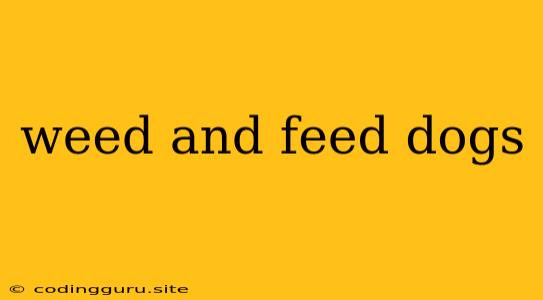Should You Use Weed and Feed on Your Lawn When You Have a Dog?
Owning a dog is a wonderful experience, but it comes with responsibilities, including ensuring their safety. One common concern for dog owners is the use of lawn care products, particularly those containing herbicides and fertilizers known as "weed and feed". While weed and feed products offer convenience by tackling both weeds and fertilizing your lawn in one application, the potential risks to your furry friend should be considered.
What are the Dangers of Weed and Feed to Dogs?
Weed and feed products typically contain chemicals like 2,4-D, dicamba, and glyphosate, which can be harmful to dogs if ingested. These chemicals can cause a range of symptoms, including:
- Gastrointestinal upset: Vomiting, diarrhea, and abdominal pain.
- Nervous system issues: Tremors, seizures, and weakness.
- Liver and kidney damage: Long-term exposure can affect organ function.
- Skin irritation: Contact with the chemicals can cause rashes and itching.
The severity of the symptoms depends on the amount ingested, the type of chemicals, and the dog's size and health.
How Can Dogs Get Exposed to Weed and Feed?
Dogs can be exposed to weed and feed products in several ways:
- Direct ingestion: Curious dogs may lick or eat granules from the lawn.
- Indirect ingestion: Dogs may ingest contaminated grass or water after the product has been applied.
- Skin contact: Dogs may come into contact with the chemicals while playing on the treated lawn.
Tips for Minimizing Risks:
If you must use weed and feed, here are some tips to help minimize the risk to your dog:
- Choose pet-friendly products: Look for products labelled as safe for pets. These products typically contain lower concentrations of herbicides and fertilizers, but still, read the label carefully and follow the instructions.
- Apply carefully: Follow the instructions on the product label carefully. Apply the product evenly and avoid over-application.
- Keep your dog off the treated area: Keep your dog off the lawn for at least 24 hours after application.
- Water deeply: Water the lawn thoroughly after applying the product to help it penetrate the soil and reduce the risk of surface contact.
- Monitor your dog: Be observant of your dog's behavior and look for any signs of illness. Contact your veterinarian immediately if you suspect your dog has been poisoned.
Safer Alternatives to Weed and Feed
Consider these safer alternatives to traditional weed and feed products:
- Natural weed control: Hand-pulling weeds, using vinegar, or organic herbicides.
- Pre-emergent herbicides: These products prevent weeds from germinating but don't harm established plants.
- Organic fertilizers: These fertilizers nourish your lawn without harmful chemicals.
Conclusion:
Using weed and feed products on your lawn when you have a dog poses potential risks to your pet's health. By understanding the dangers, taking precautions, and exploring safer alternatives, you can keep your lawn healthy and your furry friend safe. Remember, always consult your veterinarian for any concerns about your dog's health.
